Microeconomics Assignment: Operation Barga, Incentives, and Efficiency
VerifiedAdded on 2022/10/11
|10
|2767
|11
Homework Assignment
AI Summary
This assignment delves into microeconomic principles through the lens of Operation Barga, a land reform initiative in West Bengal. The solution explores economic incentives, analyzing how the policy impacted farmers (Bargadars) by providing them with greater crop shares and security, and the la...
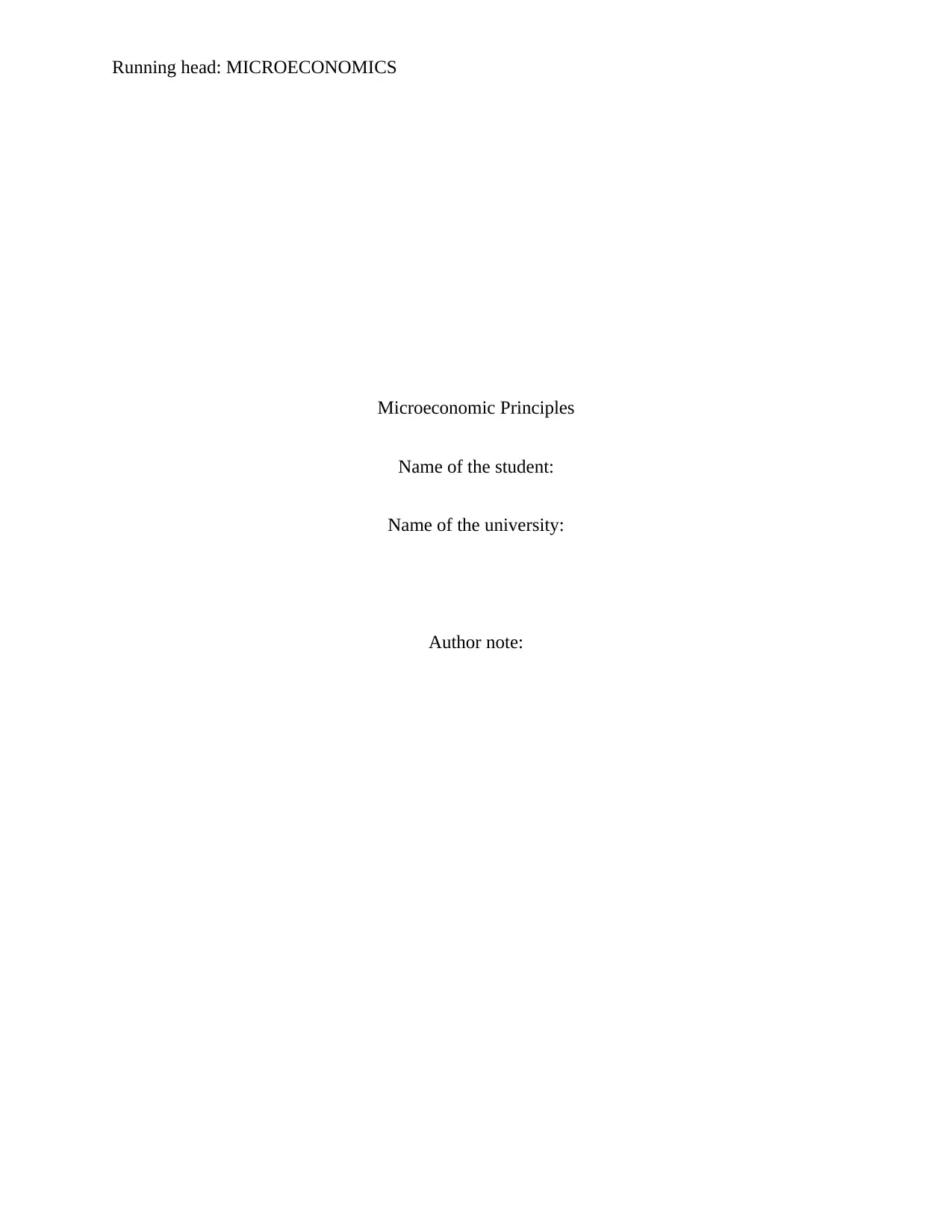
Running head: MICROECONOMICS
Microeconomic Principles
Name of the student:
Name of the university:
Author note:
Microeconomic Principles
Name of the student:
Name of the university:
Author note:
Paraphrase This Document
Need a fresh take? Get an instant paraphrase of this document with our AI Paraphraser
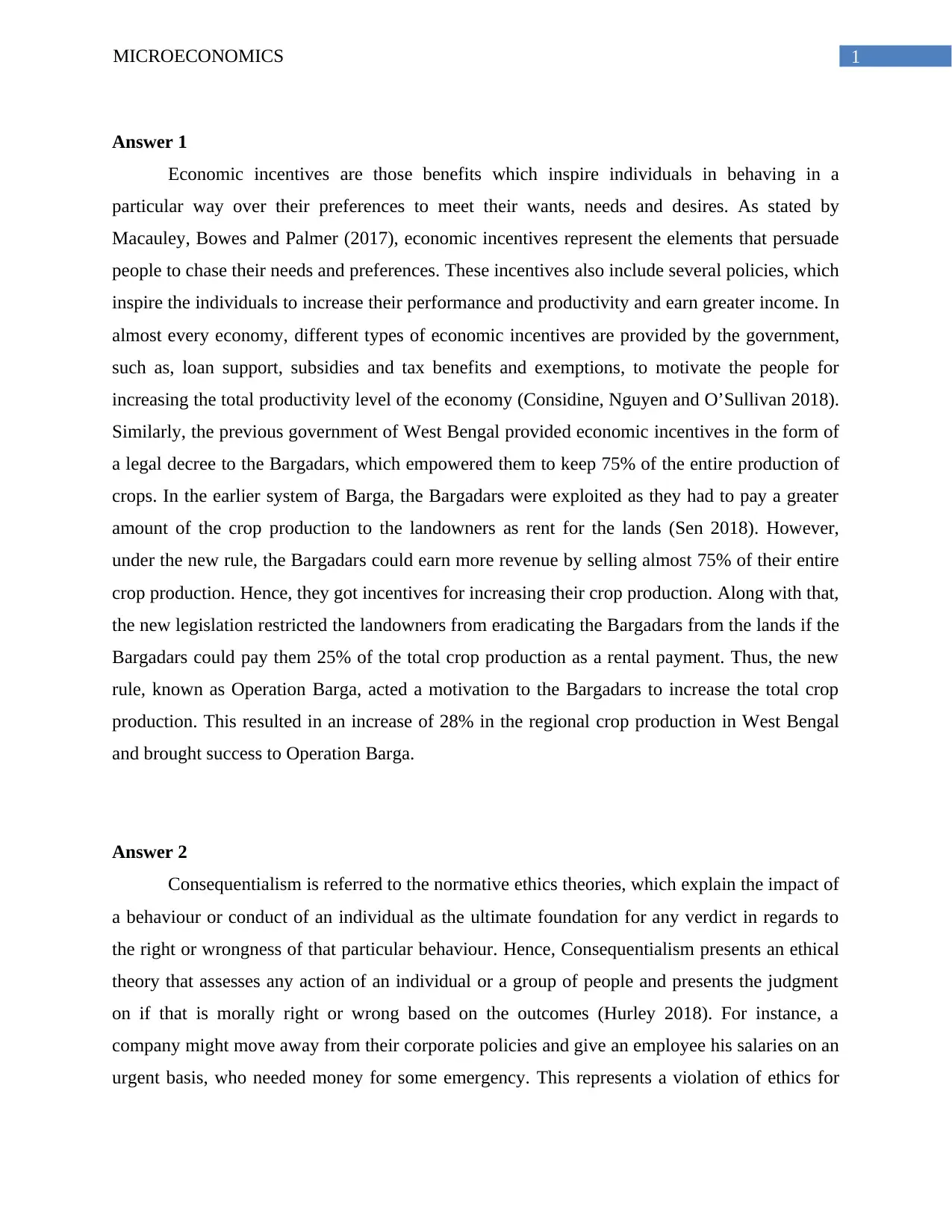
1MICROECONOMICS
Answer 1
Economic incentives are those benefits which inspire individuals in behaving in a
particular way over their preferences to meet their wants, needs and desires. As stated by
Macauley, Bowes and Palmer (2017), economic incentives represent the elements that persuade
people to chase their needs and preferences. These incentives also include several policies, which
inspire the individuals to increase their performance and productivity and earn greater income. In
almost every economy, different types of economic incentives are provided by the government,
such as, loan support, subsidies and tax benefits and exemptions, to motivate the people for
increasing the total productivity level of the economy (Considine, Nguyen and O’Sullivan 2018).
Similarly, the previous government of West Bengal provided economic incentives in the form of
a legal decree to the Bargadars, which empowered them to keep 75% of the entire production of
crops. In the earlier system of Barga, the Bargadars were exploited as they had to pay a greater
amount of the crop production to the landowners as rent for the lands (Sen 2018). However,
under the new rule, the Bargadars could earn more revenue by selling almost 75% of their entire
crop production. Hence, they got incentives for increasing their crop production. Along with that,
the new legislation restricted the landowners from eradicating the Bargadars from the lands if the
Bargadars could pay them 25% of the total crop production as a rental payment. Thus, the new
rule, known as Operation Barga, acted a motivation to the Bargadars to increase the total crop
production. This resulted in an increase of 28% in the regional crop production in West Bengal
and brought success to Operation Barga.
Answer 2
Consequentialism is referred to the normative ethics theories, which explain the impact of
a behaviour or conduct of an individual as the ultimate foundation for any verdict in regards to
the right or wrongness of that particular behaviour. Hence, Consequentialism presents an ethical
theory that assesses any action of an individual or a group of people and presents the judgment
on if that is morally right or wrong based on the outcomes (Hurley 2018). For instance, a
company might move away from their corporate policies and give an employee his salaries on an
urgent basis, who needed money for some emergency. This represents a violation of ethics for
Answer 1
Economic incentives are those benefits which inspire individuals in behaving in a
particular way over their preferences to meet their wants, needs and desires. As stated by
Macauley, Bowes and Palmer (2017), economic incentives represent the elements that persuade
people to chase their needs and preferences. These incentives also include several policies, which
inspire the individuals to increase their performance and productivity and earn greater income. In
almost every economy, different types of economic incentives are provided by the government,
such as, loan support, subsidies and tax benefits and exemptions, to motivate the people for
increasing the total productivity level of the economy (Considine, Nguyen and O’Sullivan 2018).
Similarly, the previous government of West Bengal provided economic incentives in the form of
a legal decree to the Bargadars, which empowered them to keep 75% of the entire production of
crops. In the earlier system of Barga, the Bargadars were exploited as they had to pay a greater
amount of the crop production to the landowners as rent for the lands (Sen 2018). However,
under the new rule, the Bargadars could earn more revenue by selling almost 75% of their entire
crop production. Hence, they got incentives for increasing their crop production. Along with that,
the new legislation restricted the landowners from eradicating the Bargadars from the lands if the
Bargadars could pay them 25% of the total crop production as a rental payment. Thus, the new
rule, known as Operation Barga, acted a motivation to the Bargadars to increase the total crop
production. This resulted in an increase of 28% in the regional crop production in West Bengal
and brought success to Operation Barga.
Answer 2
Consequentialism is referred to the normative ethics theories, which explain the impact of
a behaviour or conduct of an individual as the ultimate foundation for any verdict in regards to
the right or wrongness of that particular behaviour. Hence, Consequentialism presents an ethical
theory that assesses any action of an individual or a group of people and presents the judgment
on if that is morally right or wrong based on the outcomes (Hurley 2018). For instance, a
company might move away from their corporate policies and give an employee his salaries on an
urgent basis, who needed money for some emergency. This represents a violation of ethics for
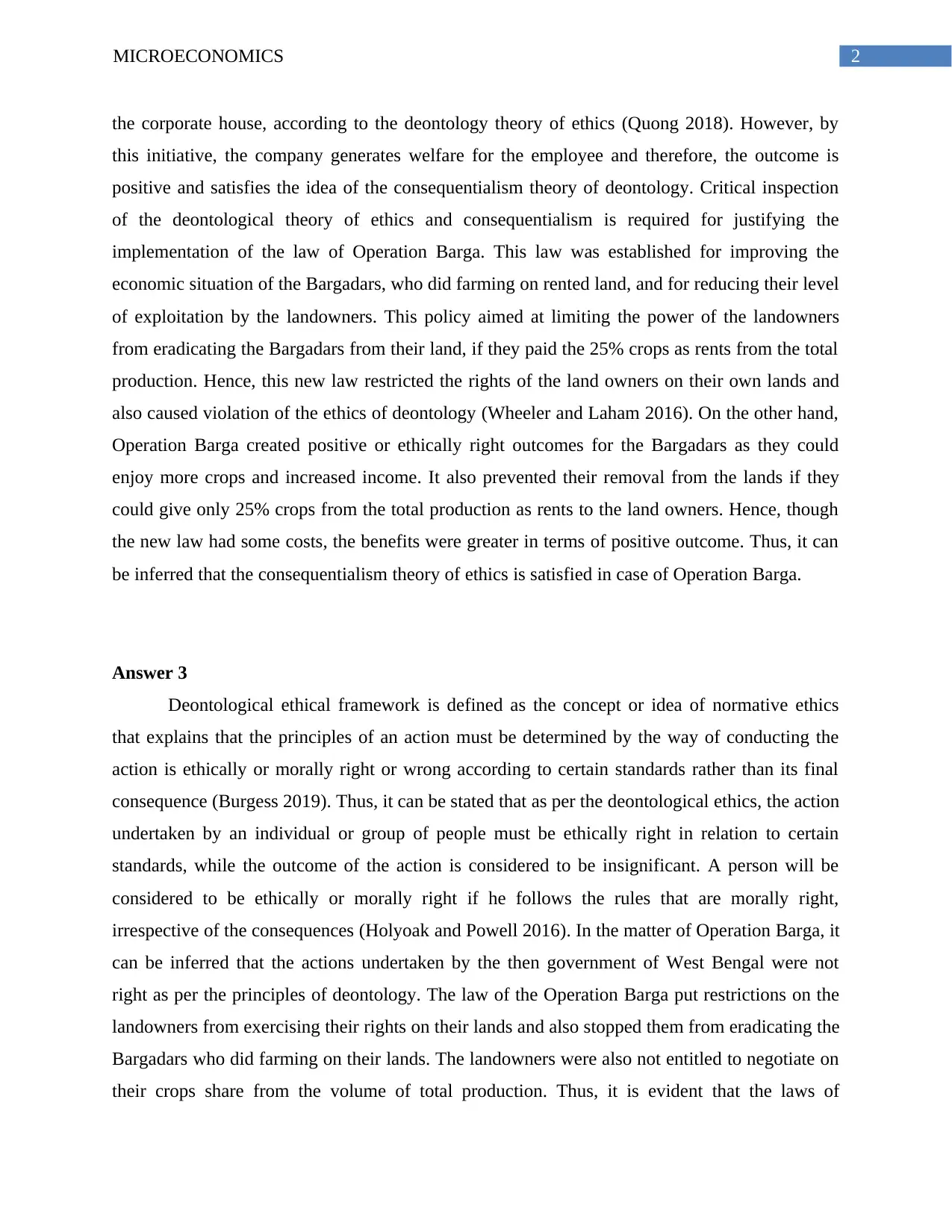
2MICROECONOMICS
the corporate house, according to the deontology theory of ethics (Quong 2018). However, by
this initiative, the company generates welfare for the employee and therefore, the outcome is
positive and satisfies the idea of the consequentialism theory of deontology. Critical inspection
of the deontological theory of ethics and consequentialism is required for justifying the
implementation of the law of Operation Barga. This law was established for improving the
economic situation of the Bargadars, who did farming on rented land, and for reducing their level
of exploitation by the landowners. This policy aimed at limiting the power of the landowners
from eradicating the Bargadars from their land, if they paid the 25% crops as rents from the total
production. Hence, this new law restricted the rights of the land owners on their own lands and
also caused violation of the ethics of deontology (Wheeler and Laham 2016). On the other hand,
Operation Barga created positive or ethically right outcomes for the Bargadars as they could
enjoy more crops and increased income. It also prevented their removal from the lands if they
could give only 25% crops from the total production as rents to the land owners. Hence, though
the new law had some costs, the benefits were greater in terms of positive outcome. Thus, it can
be inferred that the consequentialism theory of ethics is satisfied in case of Operation Barga.
Answer 3
Deontological ethical framework is defined as the concept or idea of normative ethics
that explains that the principles of an action must be determined by the way of conducting the
action is ethically or morally right or wrong according to certain standards rather than its final
consequence (Burgess 2019). Thus, it can be stated that as per the deontological ethics, the action
undertaken by an individual or group of people must be ethically right in relation to certain
standards, while the outcome of the action is considered to be insignificant. A person will be
considered to be ethically or morally right if he follows the rules that are morally right,
irrespective of the consequences (Holyoak and Powell 2016). In the matter of Operation Barga, it
can be inferred that the actions undertaken by the then government of West Bengal were not
right as per the principles of deontology. The law of the Operation Barga put restrictions on the
landowners from exercising their rights on their lands and also stopped them from eradicating the
Bargadars who did farming on their lands. The landowners were also not entitled to negotiate on
their crops share from the volume of total production. Thus, it is evident that the laws of
the corporate house, according to the deontology theory of ethics (Quong 2018). However, by
this initiative, the company generates welfare for the employee and therefore, the outcome is
positive and satisfies the idea of the consequentialism theory of deontology. Critical inspection
of the deontological theory of ethics and consequentialism is required for justifying the
implementation of the law of Operation Barga. This law was established for improving the
economic situation of the Bargadars, who did farming on rented land, and for reducing their level
of exploitation by the landowners. This policy aimed at limiting the power of the landowners
from eradicating the Bargadars from their land, if they paid the 25% crops as rents from the total
production. Hence, this new law restricted the rights of the land owners on their own lands and
also caused violation of the ethics of deontology (Wheeler and Laham 2016). On the other hand,
Operation Barga created positive or ethically right outcomes for the Bargadars as they could
enjoy more crops and increased income. It also prevented their removal from the lands if they
could give only 25% crops from the total production as rents to the land owners. Hence, though
the new law had some costs, the benefits were greater in terms of positive outcome. Thus, it can
be inferred that the consequentialism theory of ethics is satisfied in case of Operation Barga.
Answer 3
Deontological ethical framework is defined as the concept or idea of normative ethics
that explains that the principles of an action must be determined by the way of conducting the
action is ethically or morally right or wrong according to certain standards rather than its final
consequence (Burgess 2019). Thus, it can be stated that as per the deontological ethics, the action
undertaken by an individual or group of people must be ethically right in relation to certain
standards, while the outcome of the action is considered to be insignificant. A person will be
considered to be ethically or morally right if he follows the rules that are morally right,
irrespective of the consequences (Holyoak and Powell 2016). In the matter of Operation Barga, it
can be inferred that the actions undertaken by the then government of West Bengal were not
right as per the principles of deontology. The law of the Operation Barga put restrictions on the
landowners from exercising their rights on their lands and also stopped them from eradicating the
Bargadars who did farming on their lands. The landowners were also not entitled to negotiate on
their crops share from the volume of total production. Thus, it is evident that the laws of
⊘ This is a preview!⊘
Do you want full access?
Subscribe today to unlock all pages.

Trusted by 1+ million students worldwide
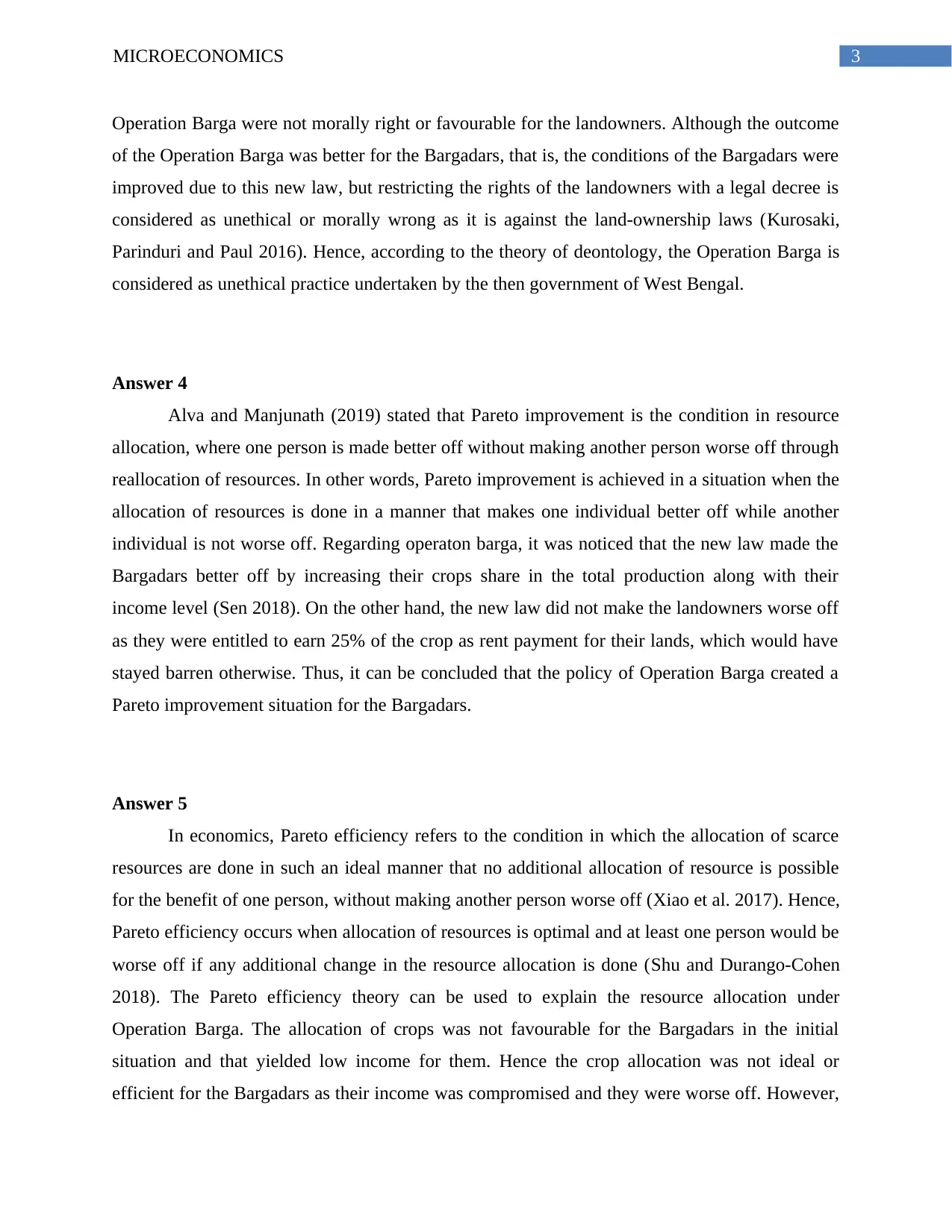
3MICROECONOMICS
Operation Barga were not morally right or favourable for the landowners. Although the outcome
of the Operation Barga was better for the Bargadars, that is, the conditions of the Bargadars were
improved due to this new law, but restricting the rights of the landowners with a legal decree is
considered as unethical or morally wrong as it is against the land-ownership laws (Kurosaki,
Parinduri and Paul 2016). Hence, according to the theory of deontology, the Operation Barga is
considered as unethical practice undertaken by the then government of West Bengal.
Answer 4
Alva and Manjunath (2019) stated that Pareto improvement is the condition in resource
allocation, where one person is made better off without making another person worse off through
reallocation of resources. In other words, Pareto improvement is achieved in a situation when the
allocation of resources is done in a manner that makes one individual better off while another
individual is not worse off. Regarding operaton barga, it was noticed that the new law made the
Bargadars better off by increasing their crops share in the total production along with their
income level (Sen 2018). On the other hand, the new law did not make the landowners worse off
as they were entitled to earn 25% of the crop as rent payment for their lands, which would have
stayed barren otherwise. Thus, it can be concluded that the policy of Operation Barga created a
Pareto improvement situation for the Bargadars.
Answer 5
In economics, Pareto efficiency refers to the condition in which the allocation of scarce
resources are done in such an ideal manner that no additional allocation of resource is possible
for the benefit of one person, without making another person worse off (Xiao et al. 2017). Hence,
Pareto efficiency occurs when allocation of resources is optimal and at least one person would be
worse off if any additional change in the resource allocation is done (Shu and Durango-Cohen
2018). The Pareto efficiency theory can be used to explain the resource allocation under
Operation Barga. The allocation of crops was not favourable for the Bargadars in the initial
situation and that yielded low income for them. Hence the crop allocation was not ideal or
efficient for the Bargadars as their income was compromised and they were worse off. However,
Operation Barga were not morally right or favourable for the landowners. Although the outcome
of the Operation Barga was better for the Bargadars, that is, the conditions of the Bargadars were
improved due to this new law, but restricting the rights of the landowners with a legal decree is
considered as unethical or morally wrong as it is against the land-ownership laws (Kurosaki,
Parinduri and Paul 2016). Hence, according to the theory of deontology, the Operation Barga is
considered as unethical practice undertaken by the then government of West Bengal.
Answer 4
Alva and Manjunath (2019) stated that Pareto improvement is the condition in resource
allocation, where one person is made better off without making another person worse off through
reallocation of resources. In other words, Pareto improvement is achieved in a situation when the
allocation of resources is done in a manner that makes one individual better off while another
individual is not worse off. Regarding operaton barga, it was noticed that the new law made the
Bargadars better off by increasing their crops share in the total production along with their
income level (Sen 2018). On the other hand, the new law did not make the landowners worse off
as they were entitled to earn 25% of the crop as rent payment for their lands, which would have
stayed barren otherwise. Thus, it can be concluded that the policy of Operation Barga created a
Pareto improvement situation for the Bargadars.
Answer 5
In economics, Pareto efficiency refers to the condition in which the allocation of scarce
resources are done in such an ideal manner that no additional allocation of resource is possible
for the benefit of one person, without making another person worse off (Xiao et al. 2017). Hence,
Pareto efficiency occurs when allocation of resources is optimal and at least one person would be
worse off if any additional change in the resource allocation is done (Shu and Durango-Cohen
2018). The Pareto efficiency theory can be used to explain the resource allocation under
Operation Barga. The allocation of crops was not favourable for the Bargadars in the initial
situation and that yielded low income for them. Hence the crop allocation was not ideal or
efficient for the Bargadars as their income was compromised and they were worse off. However,
Paraphrase This Document
Need a fresh take? Get an instant paraphrase of this document with our AI Paraphraser
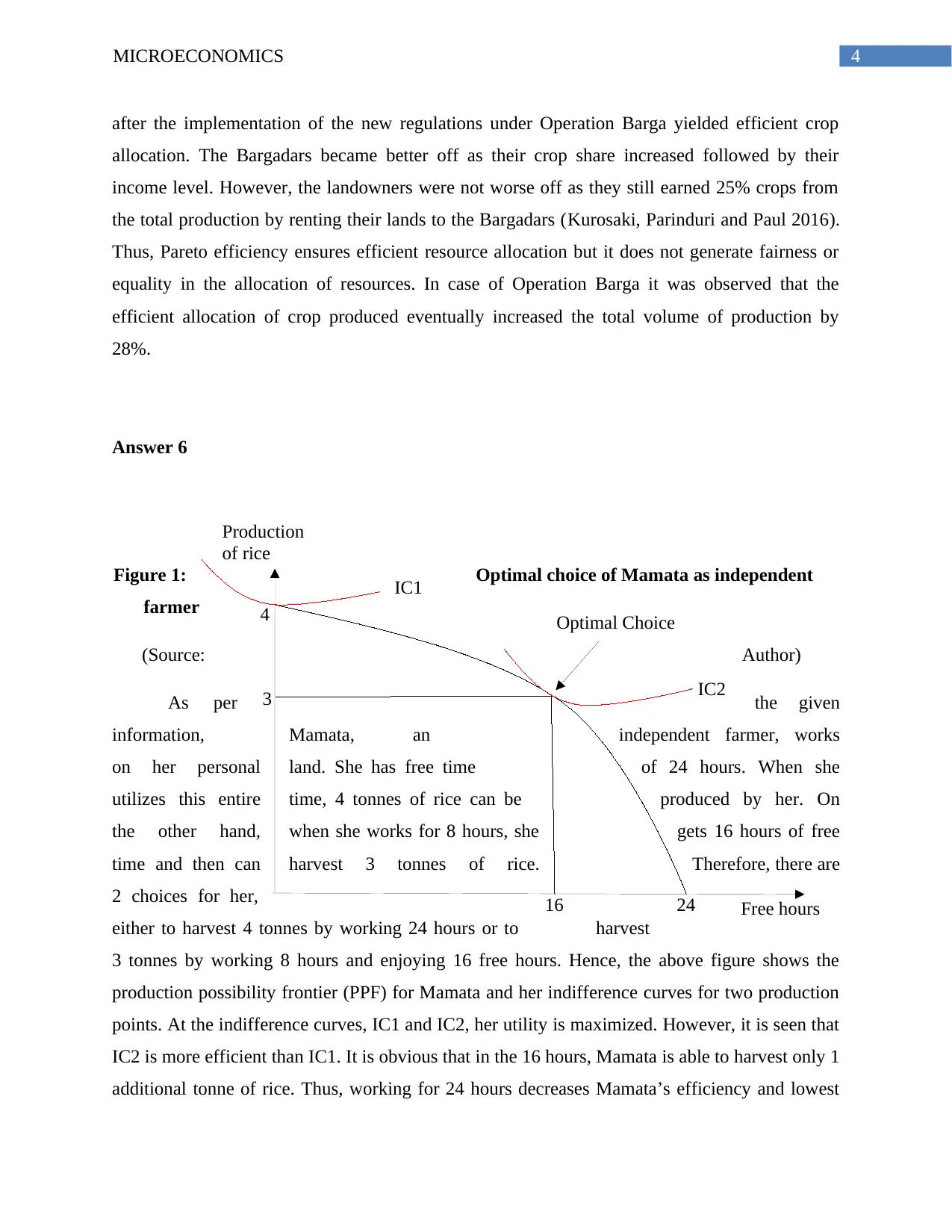
4MICROECONOMICS
IC2
IC1
3
4
16 24 Free hours
Production
of rice
Optimal Choice
after the implementation of the new regulations under Operation Barga yielded efficient crop
allocation. The Bargadars became better off as their crop share increased followed by their
income level. However, the landowners were not worse off as they still earned 25% crops from
the total production by renting their lands to the Bargadars (Kurosaki, Parinduri and Paul 2016).
Thus, Pareto efficiency ensures efficient resource allocation but it does not generate fairness or
equality in the allocation of resources. In case of Operation Barga it was observed that the
efficient allocation of crop produced eventually increased the total volume of production by
28%.
Answer 6
Figure 1: Optimal choice of Mamata as independent
farmer
(Source: Author)
As per the given
information, Mamata, an independent farmer, works
on her personal land. She has free time of 24 hours. When she
utilizes this entire time, 4 tonnes of rice can be produced by her. On
the other hand, when she works for 8 hours, she gets 16 hours of free
time and then can harvest 3 tonnes of rice. Therefore, there are
2 choices for her,
either to harvest 4 tonnes by working 24 hours or to harvest
3 tonnes by working 8 hours and enjoying 16 free hours. Hence, the above figure shows the
production possibility frontier (PPF) for Mamata and her indifference curves for two production
points. At the indifference curves, IC1 and IC2, her utility is maximized. However, it is seen that
IC2 is more efficient than IC1. It is obvious that in the 16 hours, Mamata is able to harvest only 1
additional tonne of rice. Thus, working for 24 hours decreases Mamata’s efficiency and lowest
IC2
IC1
3
4
16 24 Free hours
Production
of rice
Optimal Choice
after the implementation of the new regulations under Operation Barga yielded efficient crop
allocation. The Bargadars became better off as their crop share increased followed by their
income level. However, the landowners were not worse off as they still earned 25% crops from
the total production by renting their lands to the Bargadars (Kurosaki, Parinduri and Paul 2016).
Thus, Pareto efficiency ensures efficient resource allocation but it does not generate fairness or
equality in the allocation of resources. In case of Operation Barga it was observed that the
efficient allocation of crop produced eventually increased the total volume of production by
28%.
Answer 6
Figure 1: Optimal choice of Mamata as independent
farmer
(Source: Author)
As per the given
information, Mamata, an independent farmer, works
on her personal land. She has free time of 24 hours. When she
utilizes this entire time, 4 tonnes of rice can be produced by her. On
the other hand, when she works for 8 hours, she gets 16 hours of free
time and then can harvest 3 tonnes of rice. Therefore, there are
2 choices for her,
either to harvest 4 tonnes by working 24 hours or to harvest
3 tonnes by working 8 hours and enjoying 16 free hours. Hence, the above figure shows the
production possibility frontier (PPF) for Mamata and her indifference curves for two production
points. At the indifference curves, IC1 and IC2, her utility is maximized. However, it is seen that
IC2 is more efficient than IC1. It is obvious that in the 16 hours, Mamata is able to harvest only 1
additional tonne of rice. Thus, working for 24 hours decreases Mamata’s efficiency and lowest
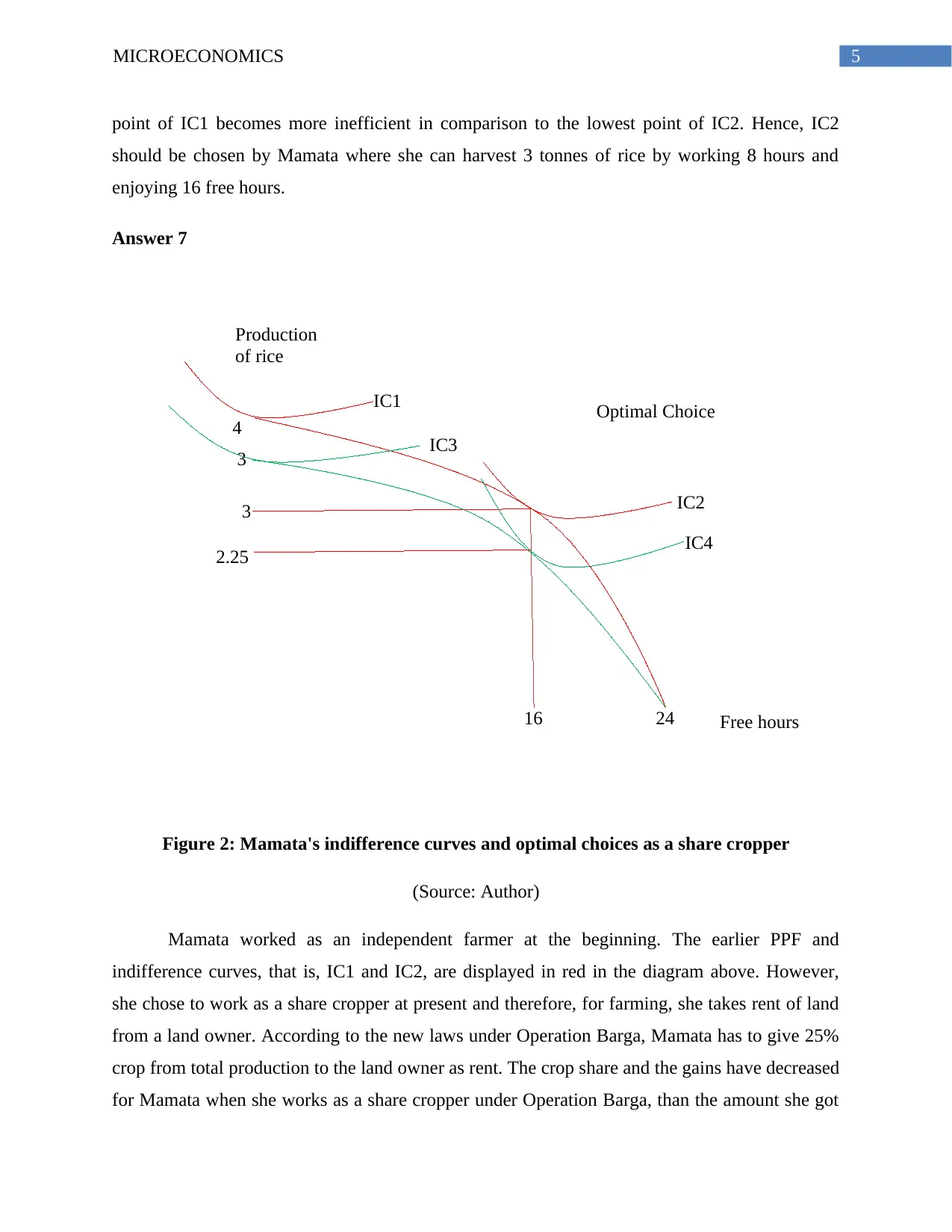
5MICROECONOMICS
IC4
2.25
IC3
3
IC2
IC1
3
4
16 24 Free hours
Production
of rice
Optimal Choice
point of IC1 becomes more inefficient in comparison to the lowest point of IC2. Hence, IC2
should be chosen by Mamata where she can harvest 3 tonnes of rice by working 8 hours and
enjoying 16 free hours.
Answer 7
Figure 2: Mamata's indifference curves and optimal choices as a share cropper
(Source: Author)
Mamata worked as an independent farmer at the beginning. The earlier PPF and
indifference curves, that is, IC1 and IC2, are displayed in red in the diagram above. However,
she chose to work as a share cropper at present and therefore, for farming, she takes rent of land
from a land owner. According to the new laws under Operation Barga, Mamata has to give 25%
crop from total production to the land owner as rent. The crop share and the gains have decreased
for Mamata when she works as a share cropper under Operation Barga, than the amount she got
IC4
2.25
IC3
3
IC2
IC1
3
4
16 24 Free hours
Production
of rice
Optimal Choice
point of IC1 becomes more inefficient in comparison to the lowest point of IC2. Hence, IC2
should be chosen by Mamata where she can harvest 3 tonnes of rice by working 8 hours and
enjoying 16 free hours.
Answer 7
Figure 2: Mamata's indifference curves and optimal choices as a share cropper
(Source: Author)
Mamata worked as an independent farmer at the beginning. The earlier PPF and
indifference curves, that is, IC1 and IC2, are displayed in red in the diagram above. However,
she chose to work as a share cropper at present and therefore, for farming, she takes rent of land
from a land owner. According to the new laws under Operation Barga, Mamata has to give 25%
crop from total production to the land owner as rent. The crop share and the gains have decreased
for Mamata when she works as a share cropper under Operation Barga, than the amount she got
⊘ This is a preview!⊘
Do you want full access?
Subscribe today to unlock all pages.

Trusted by 1+ million students worldwide
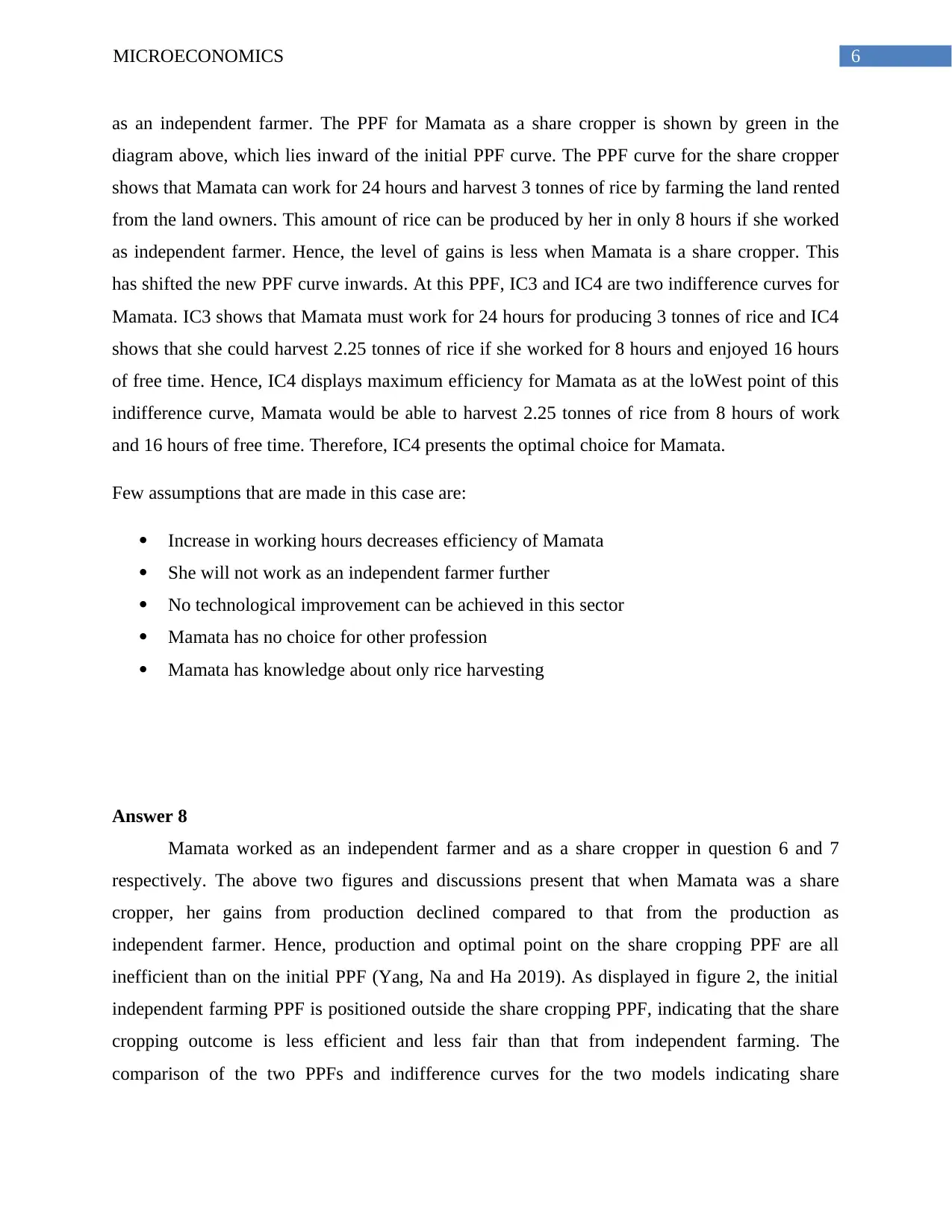
6MICROECONOMICS
as an independent farmer. The PPF for Mamata as a share cropper is shown by green in the
diagram above, which lies inward of the initial PPF curve. The PPF curve for the share cropper
shows that Mamata can work for 24 hours and harvest 3 tonnes of rice by farming the land rented
from the land owners. This amount of rice can be produced by her in only 8 hours if she worked
as independent farmer. Hence, the level of gains is less when Mamata is a share cropper. This
has shifted the new PPF curve inwards. At this PPF, IC3 and IC4 are two indifference curves for
Mamata. IC3 shows that Mamata must work for 24 hours for producing 3 tonnes of rice and IC4
shows that she could harvest 2.25 tonnes of rice if she worked for 8 hours and enjoyed 16 hours
of free time. Hence, IC4 displays maximum efficiency for Mamata as at the loWest point of this
indifference curve, Mamata would be able to harvest 2.25 tonnes of rice from 8 hours of work
and 16 hours of free time. Therefore, IC4 presents the optimal choice for Mamata.
Few assumptions that are made in this case are:
Increase in working hours decreases efficiency of Mamata
She will not work as an independent farmer further
No technological improvement can be achieved in this sector
Mamata has no choice for other profession
Mamata has knowledge about only rice harvesting
Answer 8
Mamata worked as an independent farmer and as a share cropper in question 6 and 7
respectively. The above two figures and discussions present that when Mamata was a share
cropper, her gains from production declined compared to that from the production as
independent farmer. Hence, production and optimal point on the share cropping PPF are all
inefficient than on the initial PPF (Yang, Na and Ha 2019). As displayed in figure 2, the initial
independent farming PPF is positioned outside the share cropping PPF, indicating that the share
cropping outcome is less efficient and less fair than that from independent farming. The
comparison of the two PPFs and indifference curves for the two models indicating share
as an independent farmer. The PPF for Mamata as a share cropper is shown by green in the
diagram above, which lies inward of the initial PPF curve. The PPF curve for the share cropper
shows that Mamata can work for 24 hours and harvest 3 tonnes of rice by farming the land rented
from the land owners. This amount of rice can be produced by her in only 8 hours if she worked
as independent farmer. Hence, the level of gains is less when Mamata is a share cropper. This
has shifted the new PPF curve inwards. At this PPF, IC3 and IC4 are two indifference curves for
Mamata. IC3 shows that Mamata must work for 24 hours for producing 3 tonnes of rice and IC4
shows that she could harvest 2.25 tonnes of rice if she worked for 8 hours and enjoyed 16 hours
of free time. Hence, IC4 displays maximum efficiency for Mamata as at the loWest point of this
indifference curve, Mamata would be able to harvest 2.25 tonnes of rice from 8 hours of work
and 16 hours of free time. Therefore, IC4 presents the optimal choice for Mamata.
Few assumptions that are made in this case are:
Increase in working hours decreases efficiency of Mamata
She will not work as an independent farmer further
No technological improvement can be achieved in this sector
Mamata has no choice for other profession
Mamata has knowledge about only rice harvesting
Answer 8
Mamata worked as an independent farmer and as a share cropper in question 6 and 7
respectively. The above two figures and discussions present that when Mamata was a share
cropper, her gains from production declined compared to that from the production as
independent farmer. Hence, production and optimal point on the share cropping PPF are all
inefficient than on the initial PPF (Yang, Na and Ha 2019). As displayed in figure 2, the initial
independent farming PPF is positioned outside the share cropping PPF, indicating that the share
cropping outcome is less efficient and less fair than that from independent farming. The
comparison of the two PPFs and indifference curves for the two models indicating share
Paraphrase This Document
Need a fresh take? Get an instant paraphrase of this document with our AI Paraphraser

7MICROECONOMICS
cropping and independent farming shows that the efficiency of independent farming is greater
and the outcome is fairer compared to that from share cropping.
cropping and independent farming shows that the efficiency of independent farming is greater
and the outcome is fairer compared to that from share cropping.
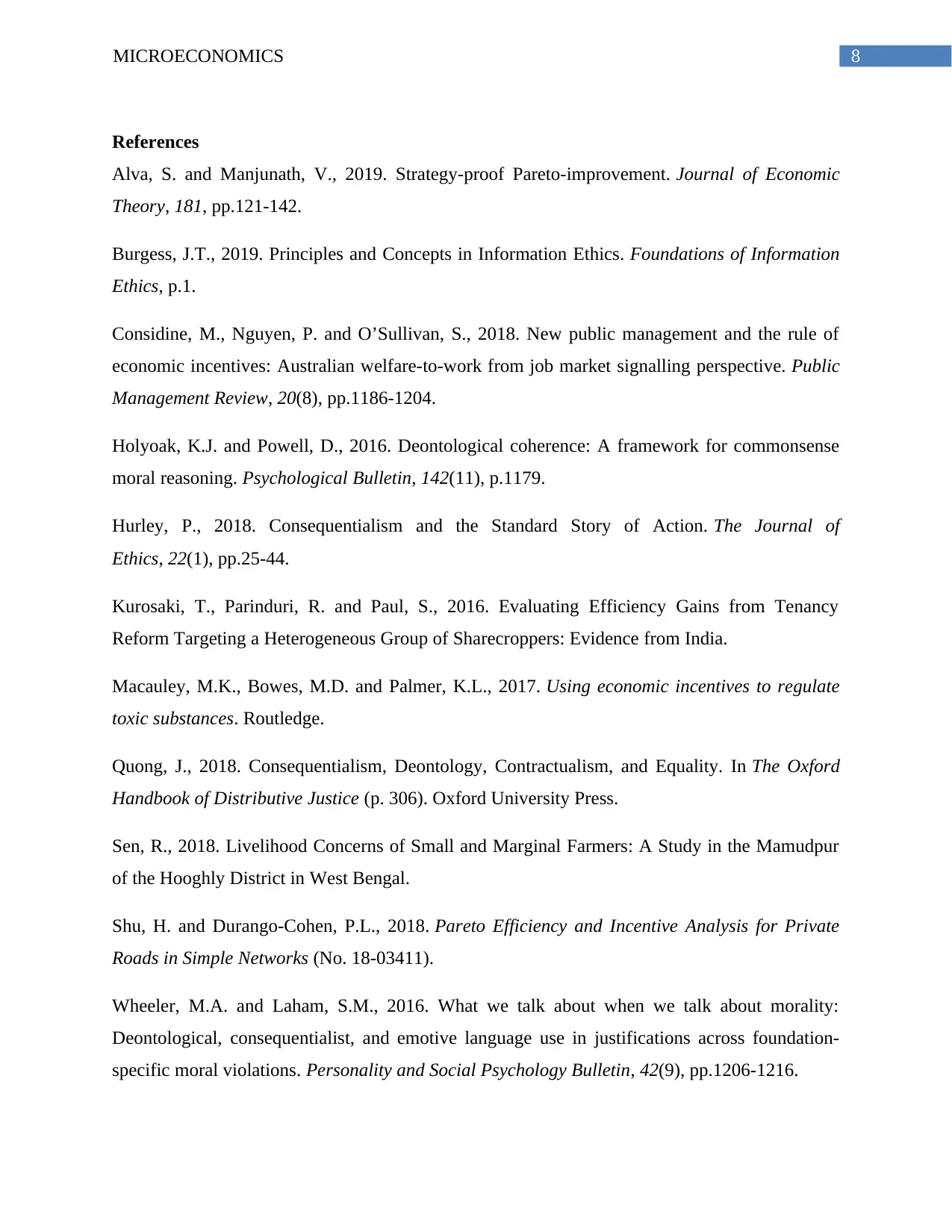
8MICROECONOMICS
References
Alva, S. and Manjunath, V., 2019. Strategy-proof Pareto-improvement. Journal of Economic
Theory, 181, pp.121-142.
Burgess, J.T., 2019. Principles and Concepts in Information Ethics. Foundations of Information
Ethics, p.1.
Considine, M., Nguyen, P. and O’Sullivan, S., 2018. New public management and the rule of
economic incentives: Australian welfare-to-work from job market signalling perspective. Public
Management Review, 20(8), pp.1186-1204.
Holyoak, K.J. and Powell, D., 2016. Deontological coherence: A framework for commonsense
moral reasoning. Psychological Bulletin, 142(11), p.1179.
Hurley, P., 2018. Consequentialism and the Standard Story of Action. The Journal of
Ethics, 22(1), pp.25-44.
Kurosaki, T., Parinduri, R. and Paul, S., 2016. Evaluating Efficiency Gains from Tenancy
Reform Targeting a Heterogeneous Group of Sharecroppers: Evidence from India.
Macauley, M.K., Bowes, M.D. and Palmer, K.L., 2017. Using economic incentives to regulate
toxic substances. Routledge.
Quong, J., 2018. Consequentialism, Deontology, Contractualism, and Equality. In The Oxford
Handbook of Distributive Justice (p. 306). Oxford University Press.
Sen, R., 2018. Livelihood Concerns of Small and Marginal Farmers: A Study in the Mamudpur
of the Hooghly District in West Bengal.
Shu, H. and Durango-Cohen, P.L., 2018. Pareto Efficiency and Incentive Analysis for Private
Roads in Simple Networks (No. 18-03411).
Wheeler, M.A. and Laham, S.M., 2016. What we talk about when we talk about morality:
Deontological, consequentialist, and emotive language use in justifications across foundation-
specific moral violations. Personality and Social Psychology Bulletin, 42(9), pp.1206-1216.
References
Alva, S. and Manjunath, V., 2019. Strategy-proof Pareto-improvement. Journal of Economic
Theory, 181, pp.121-142.
Burgess, J.T., 2019. Principles and Concepts in Information Ethics. Foundations of Information
Ethics, p.1.
Considine, M., Nguyen, P. and O’Sullivan, S., 2018. New public management and the rule of
economic incentives: Australian welfare-to-work from job market signalling perspective. Public
Management Review, 20(8), pp.1186-1204.
Holyoak, K.J. and Powell, D., 2016. Deontological coherence: A framework for commonsense
moral reasoning. Psychological Bulletin, 142(11), p.1179.
Hurley, P., 2018. Consequentialism and the Standard Story of Action. The Journal of
Ethics, 22(1), pp.25-44.
Kurosaki, T., Parinduri, R. and Paul, S., 2016. Evaluating Efficiency Gains from Tenancy
Reform Targeting a Heterogeneous Group of Sharecroppers: Evidence from India.
Macauley, M.K., Bowes, M.D. and Palmer, K.L., 2017. Using economic incentives to regulate
toxic substances. Routledge.
Quong, J., 2018. Consequentialism, Deontology, Contractualism, and Equality. In The Oxford
Handbook of Distributive Justice (p. 306). Oxford University Press.
Sen, R., 2018. Livelihood Concerns of Small and Marginal Farmers: A Study in the Mamudpur
of the Hooghly District in West Bengal.
Shu, H. and Durango-Cohen, P.L., 2018. Pareto Efficiency and Incentive Analysis for Private
Roads in Simple Networks (No. 18-03411).
Wheeler, M.A. and Laham, S.M., 2016. What we talk about when we talk about morality:
Deontological, consequentialist, and emotive language use in justifications across foundation-
specific moral violations. Personality and Social Psychology Bulletin, 42(9), pp.1206-1216.
⊘ This is a preview!⊘
Do you want full access?
Subscribe today to unlock all pages.

Trusted by 1+ million students worldwide
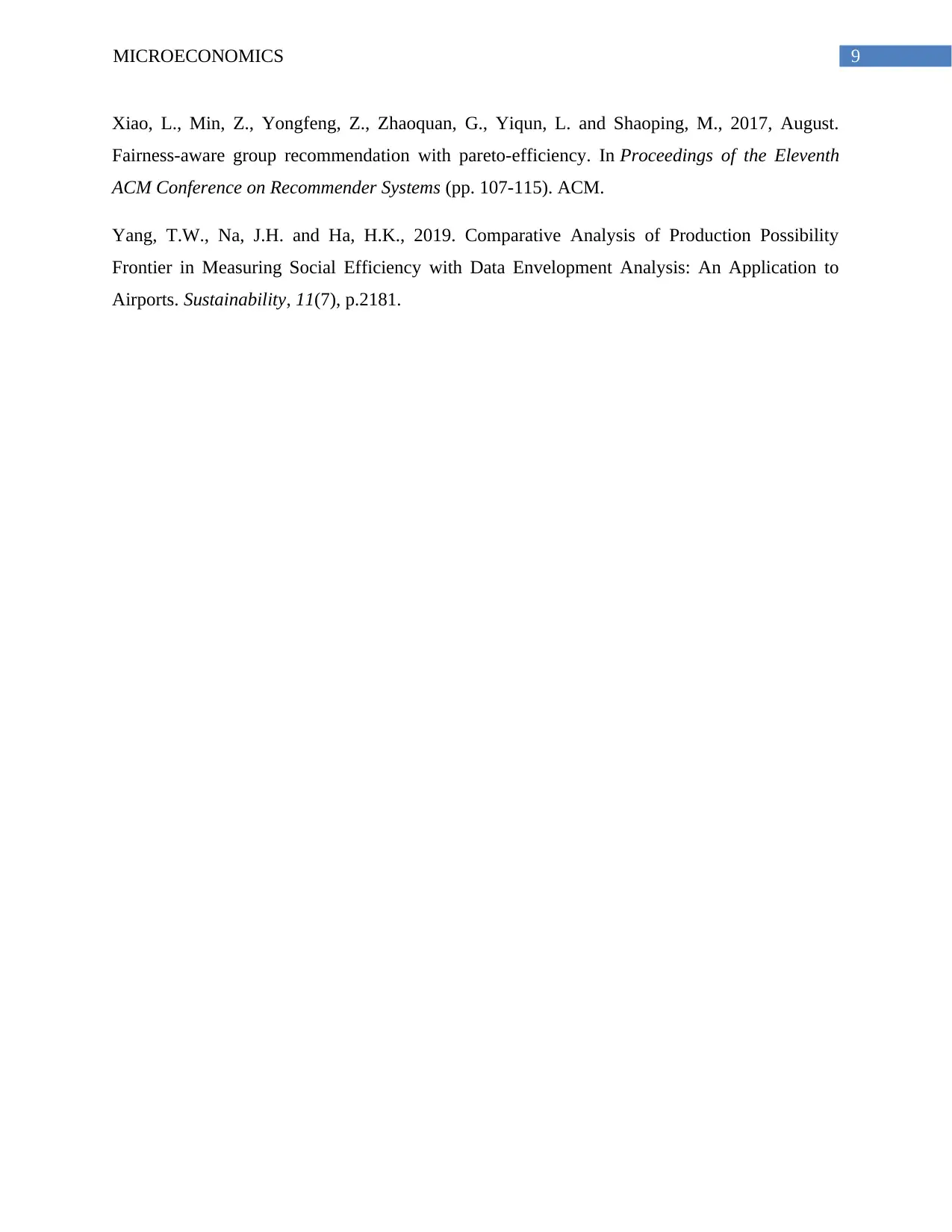
9MICROECONOMICS
Xiao, L., Min, Z., Yongfeng, Z., Zhaoquan, G., Yiqun, L. and Shaoping, M., 2017, August.
Fairness-aware group recommendation with pareto-efficiency. In Proceedings of the Eleventh
ACM Conference on Recommender Systems (pp. 107-115). ACM.
Yang, T.W., Na, J.H. and Ha, H.K., 2019. Comparative Analysis of Production Possibility
Frontier in Measuring Social Efficiency with Data Envelopment Analysis: An Application to
Airports. Sustainability, 11(7), p.2181.
Xiao, L., Min, Z., Yongfeng, Z., Zhaoquan, G., Yiqun, L. and Shaoping, M., 2017, August.
Fairness-aware group recommendation with pareto-efficiency. In Proceedings of the Eleventh
ACM Conference on Recommender Systems (pp. 107-115). ACM.
Yang, T.W., Na, J.H. and Ha, H.K., 2019. Comparative Analysis of Production Possibility
Frontier in Measuring Social Efficiency with Data Envelopment Analysis: An Application to
Airports. Sustainability, 11(7), p.2181.
1 out of 10
Related Documents
Your All-in-One AI-Powered Toolkit for Academic Success.
+13062052269
info@desklib.com
Available 24*7 on WhatsApp / Email
![[object Object]](/_next/static/media/star-bottom.7253800d.svg)
Unlock your academic potential
© 2024 | Zucol Services PVT LTD | All rights reserved.





